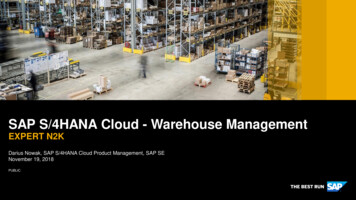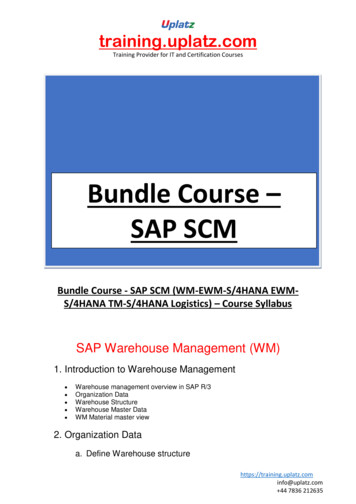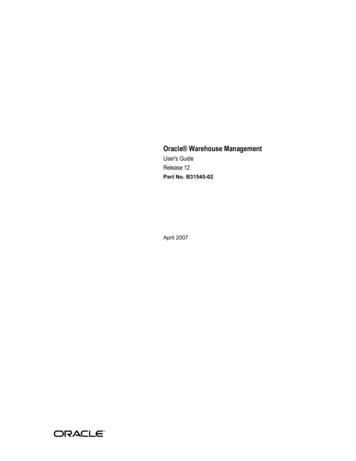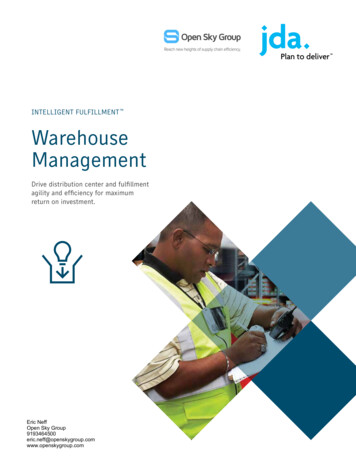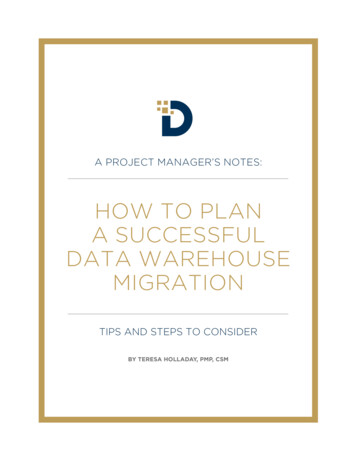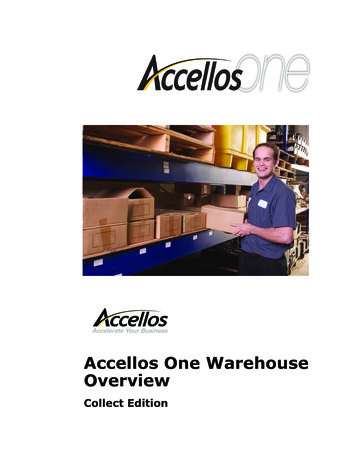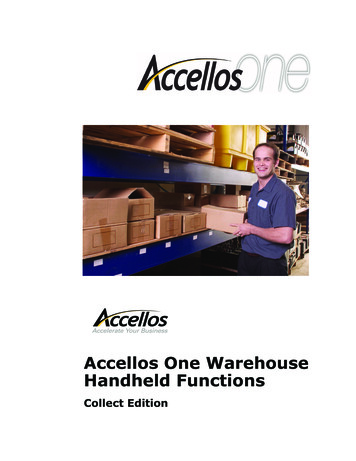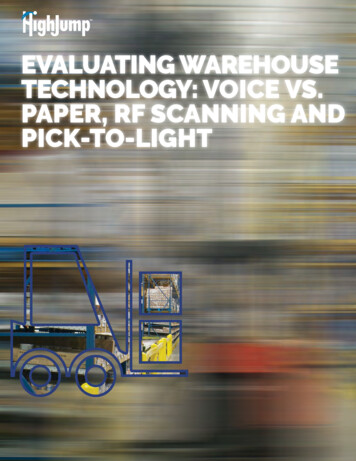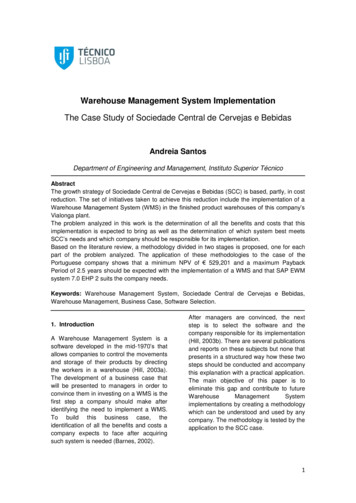
Transcription
Warehouse Management System ImplementationThe Case Study of Sociedade Central de Cervejas e BebidasAndreia SantosDepartment of Engineering and Management, Instituto Superior TécnicoAbstractThe growth strategy of Sociedade Central de Cervejas e Bebidas (SCC) is based, partly, in costreduction. The set of initiatives taken to achieve this reduction include the implementation of aWarehouse Management System (WMS) in the finished product warehouses of this company’sVialonga plant.The problem analyzed in this work is the determination of all the benefits and costs that thisimplementation is expected to bring as well as the determination of which system best meetsSCC’s needs and which company should be responsible for its implementation.Based on the literature review, a methodology divided in two stages is proposed, one for eachpart of the problem analyzed. The application of these methodologies to the case of thePortuguese company shows that a minimum NPV of 529,201 and a maximum PaybackPeriod of 2.5 years should be expected with the implementation of a WMS and that SAP EWMsystem 7.0 EHP 2 suits the company needs.Keywords: Warehouse Management System, Sociedade Central de Cervejas e Bebidas,Warehouse Management, Business Case, Software Selection.1. IntroductionA Warehouse Management System is asoftware developed in the mid-1970’s thatallows companies to control the movementsand storage of their products by directingthe workers in a warehouse (Hill, 2003a).The development of a business case thatwill be presented to managers in order toconvince them in investing on a WMS is thefirst step a company should make afteridentifying the need to implement a WMS.To build this business case, theidentification of all the benefits and costs acompany expects to face after acquiringsuch system is needed (Barnes, 2002).After managers are convinced, the nextstep is to select the software and thecompany responsible for its implementation(Hill, 2003b). There are several publicationsand reports on these subjects but none thatpresents in a structured way how these twosteps should be conducted and accompanythis explanation with a practical application.The main objective of this paper is toeliminate this gap and contribute to futureWarehouseManagementSystemimplementations by creating a methodologywhich can be understood and used by anycompany. The methodology is tested by theapplication to the SCC case.1
2. Case Study2.1. Sociedade Central de Cervejas eBebidasSociedade Central de Cervejas e Bebidasis a Portuguese company whose mainbusiness is the production of beveragesthat are distributed both in the domestic andinternational market and is part of theHeineken group since 2008. In Portugal,the SCC produces and bottles the Sagresbeer brands in its Vialonga plant andcaptures and bottles mineral and springwaters, Luso and Cruzeiro in its Vacariçaindustrial unit where Luso Fruta is alsoproduced. The Warehouse ManagementSystem (WMS) will be implemented inVialonga’s finished product warehouses.2.2. Vialonga’s PlantIt is in this plant that SCC produces bottlesand stores Sagres beer brands and theirvariants, with and without alcohol, as wellas stores imported products belonging tothe Heineken portfolio. It has 8 warehousesfrom which 3 are finished productwarehouses that store the productsproduced in the production lines, theimported products and the productsreturned by customers. The itemscontained in these warehouses are used tofulfil orders from the domestic marketcustomers as well as orders from the exportmarket customers. The WMS will beimplemented in these finished productswarehouses.2.3. Finished Product WarehousesThere are several processes occurring inthese warehouses every day such as thereceipt of imported products, managementof returns, customer sales, replenishment ofpicking areas and inventories. Currently,these processes are heavily dependent onthe knowledge and decisions made byforklift drivers and team leaders. In contrastwith the current situation, WMS will guideoperators in their daily tasks (based on areal time control of inventory) indicatingthem, for example, the storage locationwhere they should put the products that arereceivedinthefinishedproductwarehouses and where they should pick thepallets that are going to be shipped to fulfilan order. This system also allows theautomation of some processes such as thereplenishment of the picking areas(automation of processes means thatemployees are warned when they have tobe made). Furthermore, WMS supports apaper-freeenvironment,sendinginstructions wirelessly to the warehouseworkers (Hobkirk, 2007). Due to thecontrast between the current way ofworkinginthesefinishedproductwarehouses and WMS’s way of functioning,SCC expects that the implementation ofsuch a system will bring improvementssuch as better organization and use ofavailable space in storage, assurance thatFEFO (First Expired First Out) ismaintained and that the specifications ofeach client are met which will lead to areduction in returns due to productsdelivered with limited shelf life or unduepalletization and perpetual inventory systemwhere errors are almost inexistent.The differences between the current stheimprovements identified are the basis forthe application of the methodologydeveloped in this paper.3. Literature Review3.1. Justify the WMS AcquisitionTop management approval is necessaryafter the need to acquire a WMS has beenidentified. To obtain this approval, adocument (business case) containing all thebenefits (quantitative and qualitative) andcosts expected must be built. Qualitativebenefits should be included in the narrativeform while quantitative benefits should beincluded together with the costs in theeconomic justification of the project. Amongthe most used economic justification tools isthe calculation of the Net Present Value(NPV) and Payback Period. The firstcalculates the net monetary gain that isexpected of a project by discounting all2
future cash flows up to the present timeusing the rate of return required by thecompany. Cash flows can be negative(costs) or positive (income or savings).Given n the planned time frame, CF thetotal expected cash flows for each periodand i the rate of return, the NPV can becalculated as follows:𝑛𝑁𝑃𝑉(𝐶𝐹) 𝑎𝑡 𝐶𝐹𝑡 𝑡 0𝐶𝐹0𝐶𝐹1𝐶𝐹𝑛 (1 𝑖)0 (1 𝑖)1(1 𝑖)𝑛If the NPV of a project is greater than orequal to zero, the project should beaccepted because the project rate of returnequals or exceeds the rate of returnrequired by the company. If the NPV isnegative, the investment is not justified. ThePayback Period is the period of timerequired for the savings of a project to payback the initial investment, or in otherwords, when the NPV becomes zero. Ingeneral, the shorter the Payback Period,the more desirable the project. One way tostrengthen the credibility of the economicjustification is by performing a sensitivityanalysis to examine how the results willchange if the anticipated financial resultsare not achieved or if one of the underlyingassumptions changes. The sensitivityanalysis allows managers to evaluate thesafety margin associated with the projectand the key assumptions that drive thejustification. The business case can bedeveloped by an external consultant or ateam made up of company employees whohave a great knowledge of how the WMSwill change the way you work and theadvantages that these changes will bring(Barnes, 2002).3.2. WMS SelectionAfter obtaining the top managementapproval, the company needs to select thesoftware and the company responsible forits implementation (Hill, 2003b). There aresituations where the company thatdeveloped the WMS is not the one toensure its proper implementation, and thistask is assign to a consultant who has astrongexperienceinsystemimplementations (Harrington, 2001). Theselection of the best combination betweenthe software and implementing companycan be divided into six steps: form a projectteam that will not necessarily be the sameas the team that developed the justificationfor the acquisition of WMS (Hill, 2003b), thisteam should include representatives of thevariousareasaffectedbytheimplementation of the system, such aslogistics, customer service and informationsystems (Finkel, 1996); analyze the gapbetween current operations and the desiredchanges identified during development ofthe business case allows the establishmentof technical requirements; pre-select threeor four combinations that seem to be themost suitable to meet the company's needs,taking into account not only the technicalrequirements but also a set of other criteria(Hill, 2003b); thoroughly evaluate thesecombinations by contacting a fewreferences of the implementing company(Friedman, 2005), trying to understand whatwas the working relationship between it andthe company where the WMS wasimplemented (Finkel, 1996); decide whichcombinations are attractive enough that avisit to one or two references is worth(Friedman, 2005); make a decision. Theentire collection of information made shouldnot be seen as a simple ranking, acompany must be confident that all theinformation and all alternatives wereanalyzed (Finkel, 1996).4. Proposed Methodology4.1. Business Case DevelopmentThe part of the proposed methodologydeveloped to assist in the business casedevelopment for the WMS acquisition canbe divided into 8 steps and is representedin Figure 1.Learn WMSCapabilitiesIdentifyAreas ybackAuditFigure 1 – Methodology for the BusinessCase Development3
A thorough understanding of how a WMSworks, how it supports optimized practicesand how these practices fit within thecompany environment is required when acompany wants to start developing thebusiness case. Various sources can beused to learn more about WMS, includingcase studies, contact with suppliers,consultants and other users of thissoftware. After gaining more knowledgeabout the WMS, it is necessary to identifythe benefits that result from implementingthis type of system. However, not all ofthese benefits will be a reality for everycompany that is considering acquiring thistype of software. For this reason it isnecessary that each business analysis thevarious processes occurring in theirwarehouses as well as the performancemetrics used in order to identify thechanges that the WMS will cause both inthe processes as in the metrics values,allowing them to identify opportunities forimprovement for their particular case. Thisanalysis should not be limited to thewarehouse but include other areas that willalso be affected, such as customer service(Hill, 2002). As already mentioned, thebenefits identified can be classified intoqualitativeandquantitative.Thisclassification will influence how each benefitwill be included in the business case beingthat the qualitative benefits should beincluded in the narrative form andquantitative benefits should be includedtogether with the costs constituting theeconomic justification of the project.According to Barnes (2002) and Hills(2002), the set of benefits which areclassified in most cases as beingquantitative includes labor productivityimprovements, error reduction, equipmentandrespectivemaintenancecostselimination, space utilization improvements,equipment repair area reduction, inventoryaccuracy improvements, inventory levelsand carrying costs reduction, physicalinventory counts elimination, shelf lifelosses due to expiration issues reduction,shipping accuracy improvements, legacysupport reduction, legacy hardware andsoftware elimination, returns and respectivepenalties from clients reduction and paperreduction.Accordingtothesamepublications, the set of benefits which areclassified in most cases as being qualitativeincludes employee morale improvements,employee turnover and training reduction,product damage reduction, expeditedshipments and fees payed to thetransportationcompanyreduction,customer satisfaction, orders visibility andvalue added services increases andconsequently sales growth. The quantitativebenefits are also called savings and will beincluded in the economic justification aspositive cash flows (Barnes, 2002). Themethods used to estimate the quantitativebenefits that apply to the SCC’s case areexplained in the next chapter of this paper.Once identified all the benefits, it isnecessary to quantify the costs associatedwith the WMS implementation which will beincluded in the economic justification asnegative cash flows. The actual costs of aWMS can only be quantified after itsacquisition and implementation so, whendeveloping a business case, the companyneeds to estimate these costs. The dataneeded for this estimation can be obtainedusing WMS solutions suppliers orexperienced consultants. The costs can bedivided in seven categories and eachcategory can be assigned a percentage ofthe total project cost. This information issummarized in Table 1.Table 1 - Costs Categories (adapted fromBarnes, 2002)Investment CategorySoftware & HardwareSystem IntegrationSoftware VendorAssistanceHost SystemModificationsInternal Corporate CostsContingency & OtherCostsAnnual Maintenance% of Total30-6030-3510-155-105-105-1515-20The first category includes the WMS licensecost but also the costs with databases,servers, printers, PCs and scanners. In thesecond category are included costs withconsultants and operational changes and inthe third category are included costs withprofessional services provided by oject4
management. Costs associated with theinterface programming are comprised in thefourth category. The investment made inspecial training and employee retention isconsidered to be part of the fifth category.Contingency and other costs include “just incase” money. The annual maintenance costis normally priced as percent of contractvalue (Barnes, 2002). After estimating thesavings and costs that are expected with aWM
Period of 2.5 years should be expected with the implementation of a WMS and that SAP EWM system 7.0 EHP 2 suits the company needs. Keywords: Warehouse Management System, Sociedade Central de Cervejas e Bebidas, Warehouse Management, Business Case, Software Selection. 1. Introduction A Warehouse Management System is a software developed in the mid-1970’s that allows companies to

